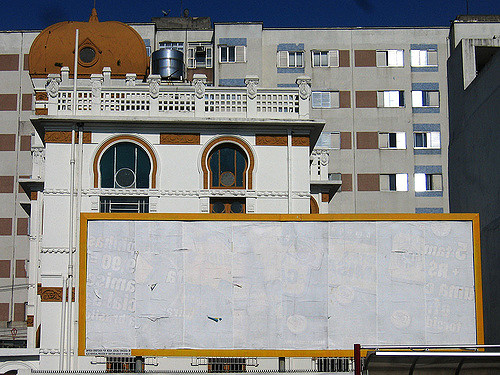
Photos courtesy of Tony Demarco, via Buzzfeed
Grenoble has decided to get rid of advertising billboards across the city, freeing up not just room for people to focus on the city they live in (rather than the products sold there), but also tens of thousands of square feet for new installations.
They are not the only city to have tried this. São Paulo in Brazil banned outdoor advertising back in 2006, and has kept the policy going because it hasn’t been catastrophic for businesses there. Your first reaction may be “but how will companies sell their shit to people?” It’s a fair question, but it’s not clear whether billboard advertising actually works. Take this stat: the average American sees 4,000 ads a day. There is no proof that any one of those ads has an effect.
And there IS proof that fewer ads make a city way more enjoyable (unless you’re in North Korea). I was writing a post about our experience in NYC, while sitting in a café in Havana. What was most noticeable was the lack of ads:
“Ad-free living in Havana, Cuba, makes that city seem like a thinker’s paradise, unsullied by toothpaste smiles, lingerie legs or fast food figures. Relaxed, colourful, healthy…a week in Cuba made my 6 years navigating the hive of New York City seem like complete madness.”
It’s a refreshing start. But it’s just a start.

So, one you’re one of the cities without advertising, what next?
Perhaps Grenoble can go the way of Philadelphia, and their “Mural Arts Program“, which is slowly but surely beautifying the city. That’s one way of filling the space. But it’s just cosmetic. Buskers are way more powerful, and way cheaper.
For example, the Edinburgh Fringe Festival brings in 2 million people and £88m to the Edinburgh economy. At least half of people polled say that Ed Fringe buskers are “a major reason” or “the main reason” that they visit the festival.
So, let’s say only a very conservative £15m of the money added to the Edinburgh economy comes from the presence of buskers. It costs the Ed Fringe £150,000 to run. So they get a 100:1 return on investment. For every £1 spent on managing the busker program, they get £100 back.
Why? Because buskers don’t require infrastructure, amps, power sockets, green rooms, fancy lighting, billboards or police. They are entirely self-contained, able to perform wherever there’s enough space. They are a phenomenally cheap alternative to ANY OTHER KIND OF ART.
If cities without advertising need to fill the space with something else, buskers are a good way to go. Their job is to let people know that they want to be entertained, and, as such, are engaging and interactive. Buskers make passersby live in the moment. Surely that’s the most effective way of making people connect with the city they live in.

How can you help?
If you run a busker festival, and have collected data on its effect on the economy VS how much it costs to put on, let us know in the comments below!